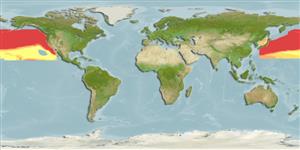>
Myctophiformes (Lanternfishes) >
Myctophidae (Lanternfishes) > Myctophinae
Etymology: Symbolophorus: Greek, symbolon, ou = mark, signal + Greek, pherein = to carry (Ref. 45335); californiensis: Named after California in the USA (Ref. 6885).
More on authors: Eigenmann & Eigenmann.
Environment: milieu / climate zone / Tiefenbereich / distribution range
Ökologie
seewasser pelagic-oceanic; tiefenbereich 557 - 1497 m (Ref. 27311). Subtropical; 55°N - 18°N, 131°E - 112°W
North Pacific: Japan, and from Alaska to Baja California, Mexico.
Size / Gewicht / Alter
Geschlechtsreife: Lm ? range ? - ? cm
Max length : 11.0 cm SL Männchen/unbestimmt; (Ref. 559)
Kurzbeschreibung
Bestimmungsschlüssel | Morphologie | Morphometrie
Rückenflossenstacheln (insgesamt) : 0; Rückenflossenweichstrahlen (insgesamt) : 13 - 15; Afterflossenstacheln: 0; Afterflossenweichstrahlen: 19 - 21; Wirbelzahl: 37 - 40. Adipose fin short based and slender; pectorals long, reaching beyond pelvic insertion but not reaching anus (Ref. 6885). Black dorsally, silvery on sides; dusky on bases of fins; light from photophores pale green (Ref. 6885). Branchiostegal rays: 9-10 (Ref. 31442).
Body shape (shape guide): elongated.
Epipelagic to mesopelagic, at surface at night (Ref. 31442). Adults feed on small crustaceans (Ref. 11712). Oviparous, with planktonic eggs and larvae (Ref. 31442). Lipid content is 4.3 % in fresh body weight, while wax ester is present in trace amounts (Ref. 9197). Preyed upon by fishes, cephalopods, birds and marine mammals. Easily attracted to a light suspended above the water at night and many are captured in dipnets (Ref. 4525).
Life cycle and mating behavior
Geschlechtsreife | Fortpflanzung | Ablaichen | Eier | Fecundity | Larven
Masuda, H., K. Amaoka, C. Araga, T. Uyeno and T. Yoshino, 1984. The fishes of the Japanese Archipelago. Vol. 1. Tokai University Press, Tokyo, Japan. 437 p. (text). (Ref. 559)
IUCN Rote Liste Status (Ref. 130435: Version 2025-1)
Bedrohung für Menschen
Harmless
Nutzung durch Menschen
Tools
Zusatzinformationen
Download XML
Internet Quellen
Estimates based on models
Preferred temperature (Ref.
123201): 3.4 - 5.2, mean 4.3 °C (based on 28 cells).
Phylogenetic diversity index (Ref.
82804): PD
50 = 0.5039 [Uniqueness, from 0.5 = low to 2.0 = high].
Bayesian length-weight: a=0.00676 (0.00293 - 0.01558), b=3.13 (2.93 - 3.33), in cm total length, based on LWR estimates for this (Sub)family-body shape (Ref.
93245).
Trophic level (Ref.
69278): 3.1 ±0.27 se; based on food items.
Generation time: 2.6 ( na - na) years. Estimated as median ln(3)/K based on 1
growth studies.
Widerstandsfähigkeit (Ref.
120179): hoch, Verdopplung der Population dauert weniger als 15 Monate. (K=0.4).
Fishing Vulnerability (Ref.
59153): Low to moderate vulnerability (28 of 100).
🛈
